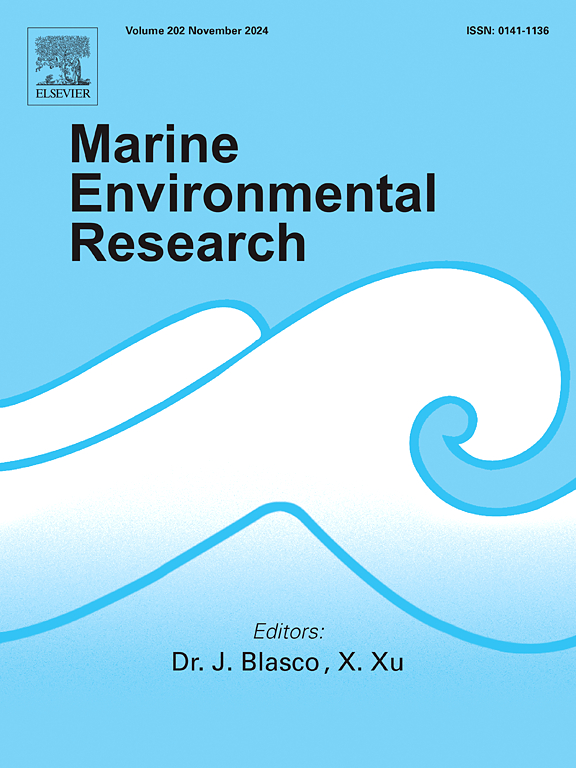Diatom Chaetoceros calcitarans MZB-1 for degrading propylbenzenes in seawater: Cultivation conditions, degradation kinetics, and influencing factors
IF 3
3区 环境科学与生态学
Q2 ENVIRONMENTAL SCIENCES
引用次数: 0
Abstract
Accidental leakage of petrochemical products (such as C9 aromatics) containing propylbenzenes (PBZs) during maritime transport poses severe threats to marine ecosystems. In this study, a PBZs-degrading diatom, Chaetoceros calcitrans MZB-1, was isolated from the seawater close to Quangang Port, Fujian Province, China, where a serious spill of C9 aromatics previously occurred several years ago. The optimal growth conditions for this alga were pH 8.5, salinity 10 ‰, temperature 25 °C and light intensity 60 μmol/(m2·s). At the optimal inoculation density (1 × 106 cells/mL), removal efficiencies of two PBZs, namely n-propylbenzene (n-PBZ) and isopropylbenzene (i-PBZ), were 68.6 % and 44.6 %, respectively, within 7 days. The elimination of each PBZ over time followed the first-order kinetic model. After adding 750 mg/L and 500 mg/L of NaHCO3 into the F/2 medium, the removal efficiencies of two PBZs increased to 70.8 % and 51.2 %, respectively. These results showed that alga MZB-1 could be more effectively used for bioremediation of PBZs-contaminated seawater than the one previously isolated.

含丙基苯(PBZs)的石化产品(如 C9 芳烃)在海上运输过程中的意外泄漏对海洋生态系统构成了严重威胁。本研究从中国福建省泉港附近的海水中分离出一种降解 PBZs 的硅藻 Chaetoceros calcitrans MZB-1。该藻的最佳生长条件为 pH 值 8.5、盐度 10 ‰、温度 25 ℃、光照强度 60 μmol/(m2-s)。在最佳接种密度(1×106 个细胞/毫升)下,7 天内对两种 PBZ(正丙基苯(n-PBZ)和异丙基苯(i-PBZ))的去除率分别为 68.6% 和 44.6%。随着时间的推移,每种 PBZ 的消除均遵循一阶动力学模型。在 F/2 培养基中分别加入 750 毫克/升和 500 毫克/升的 NaHCO3 后,两种 PBZ 的去除率分别提高到 70.8 % 和 51.2 %。这些结果表明,与之前分离出的藻类相比,MZB-1 能更有效地用于受 PBZs 污染海水的生物修复。
本文章由计算机程序翻译,如有差异,请以英文原文为准。
求助全文
约1分钟内获得全文
求助全文
来源期刊

Marine environmental research
环境科学-毒理学
CiteScore
5.90
自引率
3.00%
发文量
217
审稿时长
46 days
期刊介绍:
Marine Environmental Research publishes original research papers on chemical, physical, and biological interactions in the oceans and coastal waters. The journal serves as a forum for new information on biology, chemistry, and toxicology and syntheses that advance understanding of marine environmental processes.
Submission of multidisciplinary studies is encouraged. Studies that utilize experimental approaches to clarify the roles of anthropogenic and natural causes of changes in marine ecosystems are especially welcome, as are those studies that represent new developments of a theoretical or conceptual aspect of marine science. All papers published in this journal are reviewed by qualified peers prior to acceptance and publication. Examples of topics considered to be appropriate for the journal include, but are not limited to, the following:
– The extent, persistence, and consequences of change and the recovery from such change in natural marine systems
– The biochemical, physiological, and ecological consequences of contaminants to marine organisms and ecosystems
– The biogeochemistry of naturally occurring and anthropogenic substances
– Models that describe and predict the above processes
– Monitoring studies, to the extent that their results provide new information on functional processes
– Methodological papers describing improved quantitative techniques for the marine sciences.
 求助内容:
求助内容: 应助结果提醒方式:
应助结果提醒方式:


